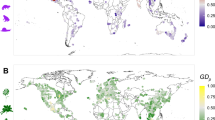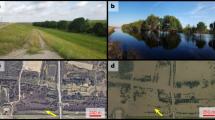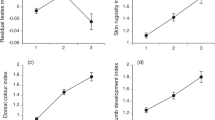Abstract
Examination of the geographic distributions of sexual organisms and their asexual, or parthenogenetic, competitors reveals certain consistent patterns. These patterns are called geographic parthenogenes is1,2,3,4,5,6,7,8. For example, if we compare sexual organisms with closely related asexuals, we find that, in the Northern Hemisphere, there is a strong tendency for the asexuals to occur further to the north. One researcher to document this pattern is Bierzychudek, who examined 43 cases (drawn from 10 genera) where the geographic distributions of a sexual plant and a closely related asexual are known4. In 76% of these cases, the asexual plant's range was more northerly than the range of the sexual. Some of the remaining cases probably fit with this pattern, but more data must be obtained before this suggestion can be confirmed. Asexuals also tend to occur at high altitudes, and in marginal, resource-poor environments1,2,3,4,5,6,7,8. We have constructed a mathematical model of a habitat that stretches from south to north in the Northern Hemisphere. Our computer simulations based on this model support the idea that a single basic process may account for much of what is known about geographic parthenogenesis. This process involves the movement of individuals from areas in which they are well adapted to areas where they are poorly adapted.
This is a preview of subscription content, access via your institution
Access options
Subscribe to this journal
Receive 51 print issues and online access
$199.00 per year
only $3.90 per issue
Buy this article
- Purchase on Springer Link
- Instant access to full article PDF
Prices may be subject to local taxes which are calculated during checkout


Similar content being viewed by others
References
Vandel, A. La parthéngénèse géographique: contribution l'étude biologique et cytologique de la parthénogénèse naturelle. Bull. Biol. Belg. 62, 164–281 (1928).
Suomalainen, E. Parthenogenesis in animals. Adv. Genet. 3, 193–253 (1950).
Lynch, M. Destabilizing hybridization, general-purpose genotypes and geographic parthenogenesis. Q. Rev. Biol. 59, 257–290 (1984).
Bierzychudek, P. Patterns in plant parthenogenesis. Experientia 41, 1255–1263 (1985).
Hughes, R. N. A Functional Biology of Clonal Animals (Chapman and Hall, London, 1989).
Glesener, R. R. & Tilman, D. Sexuality and the components of environmental uncertainty: Clues from geographic parthenogenesis in terrestrial animals. Am. Nat. 112, 659–673 (1978).
Bell, G. The Masterpiece of Nature (Univ. California Press, San Francisco, 1982).
Parker, E. D. in Evolutionary Genetics from Molecules to Morphology (ed. Singh, R. & Krimbas, C.) (Cambridge Univ. Press, in the press).
Bulmer, M. The Mathematical Theory of Quantitative Genetics (Clarendon, Oxford, 1980).
Maynard Smith, J. The Evolution of Sex (Cambridge Univ. Press, 1978).
Charlesworth, B. Mutation-selection balance and the evolutionary advantage of sex and recombination. Genet. Res. 55, 199–221 (1990).
Hamilton, W. D., Axelrod, R. & Tanese, R. Sexual reproduction as an adaptation to resist parasites (a review). Proc. Natl Acad. Sci. USA 87, 3566–3573 (1990).
Hurst, L. D. & Peck, J. R. Recent advances in understanding of the evolution and maintenance of sex. Trends Ecol. Evol. 11, 46–52 (1996).
Kondrashov, A. S. Deleterioius mutations and the evolution of sexual reproduction. Nature 336, 435–440 (1988).
Kondrashov, A. S. Classification of hypotheses on the advantage of amphimixis. J. Hered. 84, 372–387 (1993).
Peck, J. R. Frequency dependent selection, beneficial mutations, and the evolution of sex. Proc. R. Soc. Lond. B 125, 87–92 (1993).
Peck, J. R. Aruby in the rubbish: Beneficial mutations, deleterious mutations and the evolution of sex. Genetics 137, 597–606 (1994).
Peck, J. R. Limited dispersal, deleterious mutations and the evolution of sex. Genetics 142, 1053–1060 (1996).
Peck, J. R., Barreau, G. & Heath, S. C. Imperfect genes. Fisherian mutation and the evolution of sex. Genetics 145, 1171–1199 (1997).
Michod, R. E. & Levin, B. R. The Evolution of Sex: an Examination of Current Ideas (Sinauer, Sunderland, MA, 1988).
Antonovics, J. Evolution in closely adjacent plant populations. V. Evolution of self-fertility. Heredity 23, 219–238 (1968).
Dias, P. C. Sources and sinks in population biology. Trends Ecol. Evol. 11, 326–330 (1996).
Kirkpatrick, M. & Barton, N. H. Evolution of a species range. Am. Nat. (in the press). (Author: update?)
García-Ramos, G. & Kirkpatrick, M. Genetic models of adaptation and gene flow in peripheral populations. Evolution 51, 21–28 (1997).
Barton, N. H. The probability of establishment of an advantageous mutant in a subdivided population. Genet. Res. 50, 35–40 (1987).
Acknowledgements
We thank N. H. Barton, B. Charlesworth, J. Maynard Smith, D. Parker and M. Turelli for advice and assistance.
Author information
Authors and Affiliations
Rights and permissions
About this article
Cite this article
Peck, J., Yearsley, J. & Waxman, D. Explaining the geographic distributions of sexual and asexual populations. Nature 391, 889–892 (1998). https://doi.org/10.1038/36099
Received:
Accepted:
Issue Date:
DOI: https://doi.org/10.1038/36099
This article is cited by
-
Maintenance of the sexes and persistence of a clonal organism in spatially complex metapopulations
Evolutionary Ecology (2017)
-
Life cycle and population genetics of bird cherry-oat aphids Rhopalosiphum padi in China: an important pest on wheat crops
Journal of Pest Science (2017)
-
Heritable gene expression differences between apomictic clone members in Taraxacum officinale: Insights into early stages of evolutionary divergence in asexual plants
BMC Genomics (2016)
-
Extremely low genetic diversity of the northern limit populations of Nypa fruticans (Arecaceae) on Iriomote Island, Japan
Conservation Genetics (2016)
-
Spatial distribution of genetic variation of Stenocereus pruinosus (Otto) Buxb. in Mexico: analysing evidence on the origins of its domestication
Genetic Resources and Crop Evolution (2015)
Comments
By submitting a comment you agree to abide by our Terms and Community Guidelines. If you find something abusive or that does not comply with our terms or guidelines please flag it as inappropriate.



